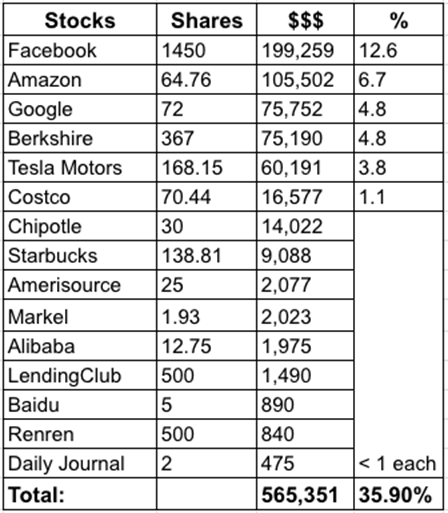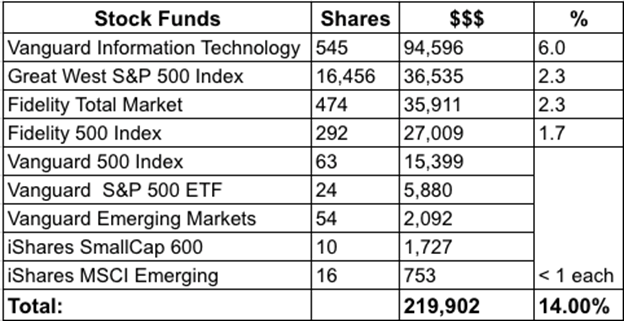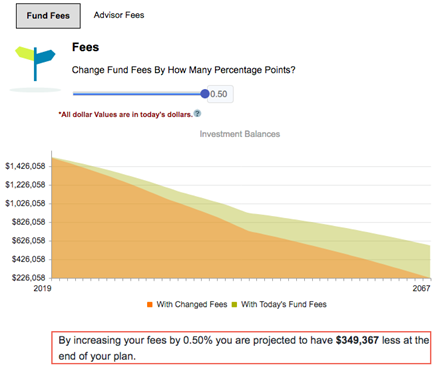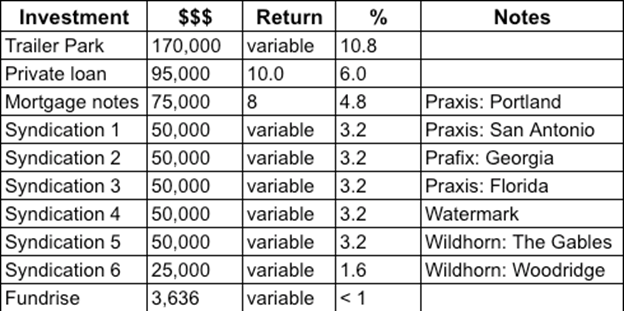Key Points:
- We take a look at a couple with two children that stopped working full time in their 40s.
- Private (not publicly traded) investments present a number of risks.
- Investment diversification is just as important once you leave the working world as it is before.
We have been writing recently about the FIRE (Financial Independence, Retire Early) movement. We did a sort of case study on one of its best-known practitioners, Root of Good , last time around. This time we'll be looking at another one that goes by the name of 1500 Days to Freedom.
Meet the 1500s
The idea behind the name of the site was that its founders wanted to get to a debt-free portfolio of $1,000,000 (starting at aboutrigh $586,000) within 1500 days of starting the blog. They made it, and then some, with a portfolio then worth around $1.3 million. They have continued to publish since hitting that mark.
Their story will be familiar to readers who have seen articles about FIRE. Young-ish people decide they want out of the "rat race," and take their journey public via a blog. They generously publish a lot of details about their financial life and their progress, along with pictures of what they're eating, travelogues, and workout routines. They get some publicity, which leads to more publicity, interviews and press appearances, and the whole thing snowballs. Having never intended to run the blog as a money making venture, the blog starts to make money via ads and affiliate links. Ancillary business opportunities arise, and because FIRE practitioners are generally go-getters by nature, they can't resist (though you can bet they would resist if they decided that it felt too much like real work).
As with many FIRE adherents, the 1500s are not retired in the days-spent-at-the-country-club sense. The "Independence" part of FIRE is what matters most: They work because they want to, not because they have to. They're not chasing a job across the country to a place they may not even want to live just because the money is better, or working their way up the ladder in some other way.
Let's have a look at what the 1500s are up to.
Their Investments
The 1500s have a smaller portfolio of publicly traded assets than most FIRE practitioners we've seen. They do have substantial holdings in private assets. More on that in a bit. For now, though, let's look at their publicly traded portfolio--which needs a lot of work.
First, the stocks:

Source: 1500days.com
This is a pretty random assortment of equities, to put it mildly. Mr. 1500 says his long-term goal is to get out of individual stocks entirely. We could not agree more that this would be a good idea in their case. He says he's doing it slowly to avoid capital gains taxes, but we would recommend speeding up that process.
Capital gains taxes, in this case, threaten to be the tail that wags the dog. That is, capital gains will be the least of their worries if the likes of Facebook, Amazon, Google, and Tesla--which, combined, make up about 80% of their stock portfolio--take a dive (and they do tend to move in the same direction). It feels recklessly aggressive to us for a semi-retired couple in their forties to have this much concentration in such stocks.
A haphazard portfolio of stocks is not the worst way to start--the most important thing is to start--but it's time for the 1500s to move on to funds and ETFs. And speaking of that, here are their current fund investments:

The 1500s say they have gotten the gospel on index funds and ETFs, so we'll mostly save our preaching about the importance of indexing and keeping investment costs low and assume that the fund allocation they have now will be the allocation they use once they've sold the individual stocks.
We do spot at least four (!) different S&P 500 index funds in their portfolio. It could be that one or more of these funds are offered in retirement plans, and the 1500s have no real choice about it. If that's not the case, they may want to consolidate--not just for simplicity's sake, but due to costs. That Great-West version of the S&P index fund, which has the largest balance, is 25 times as expensive as the Fidelity one. That is just unacceptable.
We said we'd mostly save our preaching about costs, but here's a quick example. Their weighted fund portfolio expense ratio is around 0.14%--a great, low number. Most people will have funds with expense ratios around 1% or higher. Bumping up that ratio even by 50 basis points (to 0.64%) would make a huge difference over the life of their plan, costing them about $350,000:

With WealthTrace, you can see what the effect of increasing (or lowering) your fees could be over time a plan with our Fee Scenario tool.
It's a good idea to keep tabs on your holdings so you can monitor things like fees and turnover ratios (which, when high, can lead to taxable events).

These are not the 1500s' fund investments, but with accounts linked through WealthTrace via Yodlee, you can clearly see what you're paying for each fund in fees every year. Learn more.
Once they lose the Facebook and the Baidu and all of that, and move the proceeds to their existing funds, their funds' asset allocation would look something like this:
Value Stocks: 44%
Growth Stocks: 54%
Cash: 2%
The private investments:
The 1500s have a large portion of their wealth tied up in private real-estate-related investments. One piece of their real estate portfolio is in a publicly traded vehicle (Vanguard Real Estate Index Admiral VGSLX), a very broad-based real estate fund that includes non-real-estate investments such as cell-tower and timber REITs. We have included that one in our estimate of asset allocation above, since it is publicly traded and its holdings are known.
The private portion of it, as one would expect, is a bit more opaque. It's about $620,000 worth of investments in private loans, syndicated loans, mortgage notes, and even partial ownership of a trailer park. Most of these investments reside in a self-directed 401(k).

Without knowing a ton of details about these investments, one issue we see with them is their lack of liquidity. If they're in a 401(k), illiquidity may not be a huge problem--these would not be the first assets tapped in case of emergency--but it's something to consider. Further, the vehicles they use to make some of these investments, Fundrise and Peerstreet, are relatively new and have not yet been tested by a bear market in real estate. Finally, compared to index funds, these investments (like any other managed investment) are expensive, due to the fees involved.
The biggest issue we see, though, is that the 1500s are too invested in one market sector (and they're getting into more). Their real estate investments may be geographically diversified, and may be spread across different segments of the market (such as residential and commercial), but they would all likely be subject to real estate market downturns (or garden variety economic downturns, in the case of the rental properties) moving in the same direction at the same time.
Compounding this is that Mrs. 1500 still works at a company that helps people invest in real estate--and as a licensed real estate agent as well. So if a downturn hits, it could affect their portfolio and their employment income. It's a similar idea to holding an outsize portion of stock in the company where you work: It's generally just not a good idea.
A Portfolio Makeover
The 1500s have worked hard to get where they are. They have also been helped along by some good fortune. Bull markets in real estate and stocks have been the wind at their backs.
We think it's time to make some changes to their investment portfolio that will:
- lower their risk
- lower their fees
- increase their investments' liquidity
- reduce their portfolio's complexity
- increase their diversification
- make their income less subject to market swoons
That all sounds pretty good, doesn't it?
We might propose something like this:

WealthTrace can help you get a handle on what you own--and show you what making some changes could mean to your portfolio. Sign up for a free trial.
In the above before and after, the main change is that we would reduce the portion of the portfolio that is in private real estate investments to 25%, tops. Even that is probably aggressive, but we'll grant that the 1500s have some expertise in this area and can manage a big slug of real estate investments better than most.
We would also bump up their growth stock allocation a little bit, but mostly we would get the value stock allocation a lot higher. This would include a big, diversified chunk of dividend paying stocks. With solid dividend payers, you get the income and the potential for capital appreciation, just as you would with real estate. In fact, you get everything in that bulleted list above.
The 1500s have indicated that they not want to buy individual stocks anymore, and that's fine. Options for low-fee ETFs and mutual funds that focus on dividend payers are myriad. Invesco S&P 500 High Dividend Low Volatility ETF (ticker SPHD), Vanguard High Dividend Yield ETF (ticker VYM), and Vanguard Equity-Income (ticker VEIPX) are just a few to consider.
Along with their existing Vanguard REIT fund, they could put together a low-cost portfolio of dividend stocks yielding around 4.25%. If we assume about half of their taxable portfolio is in value stocks, it could generate nearly $20,000 in income--not too shabby for the FIRE lifestyle targeting around $45,000 in spending annually--and would appreciate in value over time too.

If you do have rental properties or other real estate investments, WealthTrace can help you model your properties' capital appreciation, income, taxes, eventual sale, and more. This video explains how it works.
Hold The Sauce, Please
In the television news clip linked to above, Mrs. 1500 gets to the crux of the matter on camera:
"There’s not much to learn: Don’t spend a lot, save some, don’t spend everything you make, invest wisely. There’s no secret sauce to it."
We mostly agree. There's more than one way to retire early, but it all pretty much starts with those words.
However, proper asset allocation, while no secret sauce, is a missing ingredient here. We would like to see this family get their asset allocation in order to make the chances of having to go back to a desk job more remote.
There is still a lot more to consider--college costs for the kids, budgeting for medical expenses and even unanticipated expenses, accounting for eventual Social Security income, and so on. But we view straightening out their investment assets as a critical first step.
Find out how much you need to save in order to retire comfortably--and maybe even early. Sign up for a free trial of WealthTrace today. Learn more about how WealthTrace can help you.